The Professor and her Dinosaur
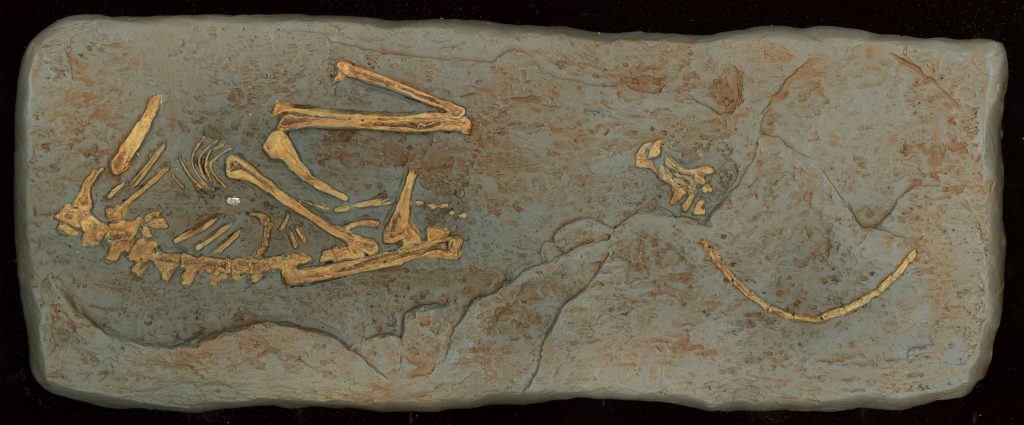
Introduction
Women are in many respects superior to men, since generally speaking, they have more patience and often more taste and discrimination in arranging collections and more deftness in manipulating materials. How true this is! 1
As Chair of the Department of Geology, Mignon Talbot wrote these words for the Mount Holyoke Alumnae Magazine in 1922. This pioneering female scientist had already achieved many firsts for women of scholarship and science. In the early twentieth century Talbot and other women of science at the College were a distinctive group, dedicated to expanding minds and opportunities for their students.

Mignon Talbot was born in Iowa City, Iowa on August 16, 1869 to Harriet Bliss Talbot and the Reverend Benjamin Talbot. The couple met and married in 1859 in Ohio where her mother was the daughter of Congregationalist physician. Dr. Bliss had moved his family from Vermont to Ohio in 1838. Mignon’s father Benjamin was born in Brooklyn, New York but following his father’s death, he was raised by his aunt in Colchester, CT. Benjamin graduated from Yale’s Divinity School and had also completed one year of graduate work. From November 1853 until August 1854 he taught at the Williston Seminary in Easthampton, MA, leaving New England to teach at the Ohio Institution for the Education of the Deaf and Dumb. In 1863 the Talbots and their six children moved to Iowa where the newly ordained Reverend Talbot became Superintendent of the Iowa School for the Deaf.
Decades before Talbot was born changes were underway that would have a profound effect on her life. The eminent 19th century scientist, educator, and minister Edward Hitchcock of Amherst College was a major force in the development the natural sciences. Making clear connections between religious belief systems, scientific methods, and natural phenomena, he became a noted figure on the national scale and in academic circles. 2 Friends of Mount Holyoke’s founder Mary Lyon, Reverend Hitchcock and his wife Orra no doubt influenced Lyon’s plans for the Mount Holyoke Seminary to incorporate natural science into the curriculum.
Hitchcock influenced the work of Geology professors, Edward Ornton and his successor Charles Prosser. At Ohio State University, they were instrumental in formulating Talbot’s fascination with Paleontology and Stratigraphy during her undergraduate years (1888-1892). 3 After graduating Phi Beta Kappa, Talbot became a teacher, as was the expectation of women in her era. The Columbus Ohio public school system had never seen the likes of this intellectually curious Physical Geography teacher. Recognizing that the approaching twentieth century may offer new opportunities for women in science, Talbot began graduate studies during the summers of 1898 (at Harvard) and 1901-1902 (at Cornell). The ambitious Talbot entered Yale University in 1902. Two years later Talbot was armed with a Ph.D. from the Geology Department – the first ever awarded to a woman – she became a driving force behind women’s roles in the academic disciplines of Geology/Geography and Paleontology.
The year 1900 marked the beginning of a new era at Mount Holyoke. Under the administration of Mary Woolley, the academic standards were raised to be equivalent to male colleges and as such the credential of Ph.D. would be required of new academic hires. Distinguished primarily by their education, clusters of faculty emerged. The self-proclaimed Daughters of Mount Holyoke College ( D’Evelyn, Coulter, and Patch) upheld the ideals of Mary Lyon while the Bryn Mawrers (Laird, Neilson, Ellis, Putnam and Hussey) and the irreverently named Daughters of the Concubines ( Talbot, Barnes ), whose alma maters varied, maintained their own ideals.
Woolley’s first academic appointment was that of Ellen Bliss Talbot, Mignon’s older sister. Ellen had also graduated Ohio State University Phi Beta Kappa. She had taught high school and had also filled the role of school principal before attending Cornell University, graduating in 1898 with a Ph.D. in Philosophy. Ellen Talbot headed the College’s joint Philosophy and Psychology Department until her retirement in 1936. 4
It was on the campus of Mount Holyoke College that the two sisters – affectionately known as the Talbi twins – became powerful influences of the community as well as in their respective disciplines. Each sister embraced the Mount Holyoke community with a sincerity and a passion to do more than their share of work on various committees.
Teaching
In 1904 while Ellen was on sabbatical, Mignon Talbot began her career at Mount Holyoke College – the only person in the Geology Department – as an Instructor teaching in Williston Hall. The Woolley administration sought to strengthen and expand the science departments, often with highly educated unmarried women scientists. That concept was reinforced and rewarded by the college as the women built their own world, a slightly distorted version of the world of outside world of male dominated science. Enthusiasm, energy, and ardent desire were valuable characteristics Woolley would look for science professors, believing that women’s ‘gift of intuition and the genius for detail, accuracy, and perseverance wrought into her nature by generations of training in her home province, especially fit her for scientific and historical research’. 5
Typically wearing a bun at the top of her head, Talbot has been described as always being in a hurry. It is no wonder her pace was swift given the heavy course load she taught, along with the expectation of being part of the community, helping in every aspect with little emphasis on publications and personal endeavors. Most of her time was spent in the Geology Department of Williston Hall which was also home to the zoology, botany, physiology, and psychology departments.
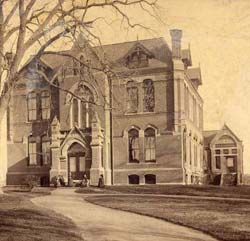
Talbot’s days were consumed with teaching classes such as Commercial Geography, Meteorology and Physiography, Mineralogy, Paleontology and Stratigraphy with classroom time exceeding nine hours a day. Lab courses and fieldwork were additional strains on her schedule. Historical Geology was added to Talbot’s course load in 1906. Her professorial status steadily climbed and by 1908 Talbot was the Chair of the Geology Department. The following year she was the first woman elected to the Paleontological Society of the United States. By 1908 courses within the science departments began to crossover one another. Fulfilling another expectation of the Woolley Administration, Talbot continued her research by traveling to Norway and Sweden during the summer of 1910.

Discovery
A petite woman known for her spunk and vivacious smile, Talbot enjoyed outdoor exploration and nature. One day in October 1910, while walking with her sister on Boynton’s farm, an area she had walked many times before, about two miles from campus, Talbot spotted a little hill off the road, commenting that it would be a great spot for a home. They strolled towards it “but the hill itself was nothing to build on. This whole accumulation of sand, gravel, boulders, and all had been dropped there by the glacier, everything brought from north of here, and some of the material from far to the north. At the bottom of the pit I saw two boulders of sandstone and other boulders of granite. On one of the sandstone pieces was a streak of white that looked like a pick mark. I was pretty sure it was only a pick mark, I went down to see it and I saw vertebrae, and I saw ribs, and I saw bones – and I said, ‘Oh, Ellen, come quick, come quick, I’ve found a real live fossil!’ 6
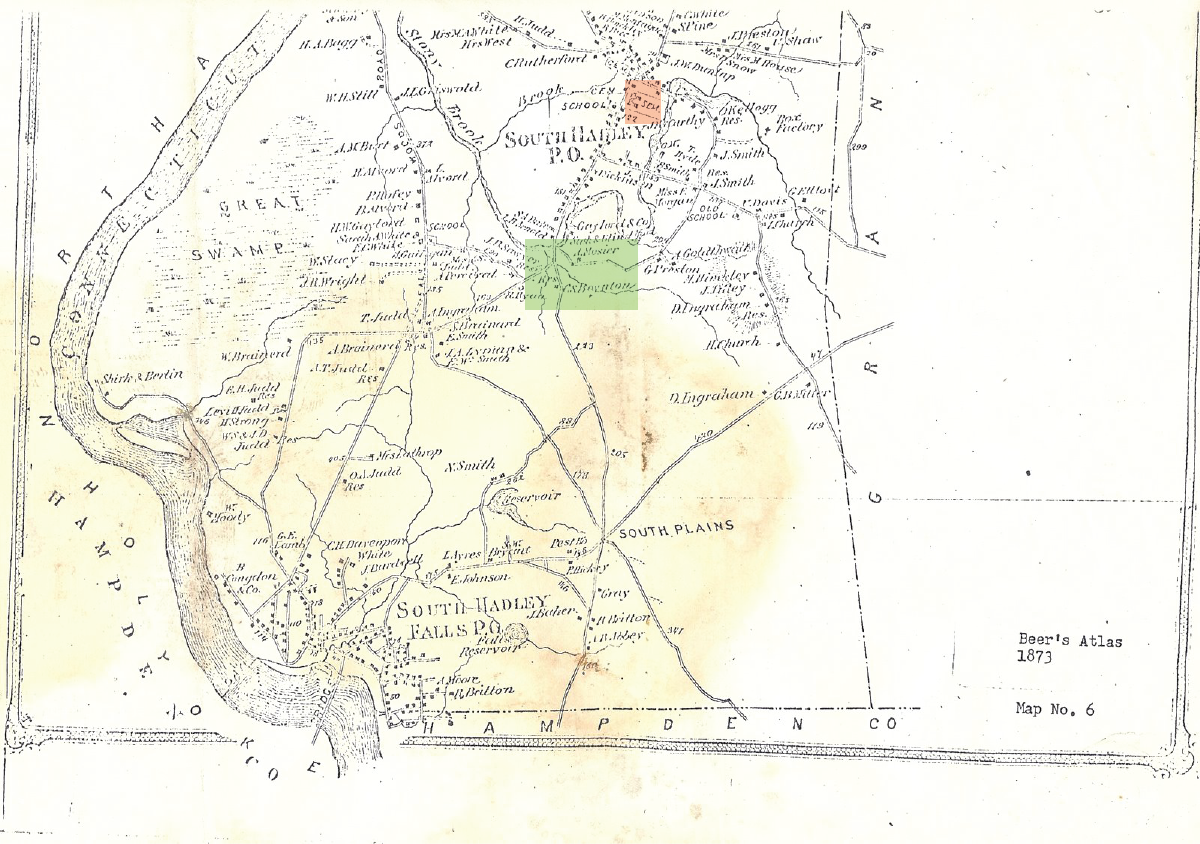
She spoke to Mr. Boynton regarding the importance of this find and received his permission to take possession of the fossil on behalf of the College. Seeking the advice of Richard Swan Lull, an authoritative dinosaur expert, the age of the dinosaur was determined and Talbot officially named her discovery Podokesaurus holyokensis in 1911. Little did she know that no such discovery would occur again on the East Coast during the entire twentieth century. While this discovery gained fame for both Mount Holyoke College and Talbot, she felt that the little dinosaur should have been sent to either Washington D.C. or to Yale for permanent exhibition. “I thought it should be with its kind.” 7 Professor Swan Lull disagreed, insisting that the fossil return to Mount Holyoke. She continued to study the dinosaur but her rigorous schedule and health issues slowed her down.
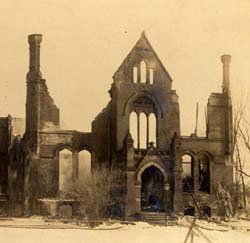
On a cold night in December of 1917 a devastating fire broke out at Williston Hall with faulty wiring being suspect. No lives were lost but the well-preserved dinosaur specimen of Podokesaurus holyokensis was destroyed along with all of Talbot’s research and other specimen collections. Firefighters did manage to save a plaster cast of Podokesaurus holyokensis (dated 1912) allowing for several copies to exist today. Talbot’s dedication to her department and science remained despite such tragedy.

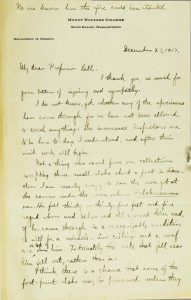
But Talbot persevered, and by the early 1920’s she had rebuilt and reinforced the department’s collection of fossils and minerals substantially. Committed to maintaining a strong department at the College, Talbot took sabbatical in 1928 traveling extensively in Austria, Switzerland, Italy, and the Balkan States for research purposes.
Retiring in 1935 as Professor Emeritus of Geology and Geography Mignon continued to live in South Hadley. She remained vital within the community although she was dealing with physical limitations. Thanks to Mignon Talbot, today’s collections of fossils and minerals at the College are comprised of over 8000 items. After a lengthy illness, Talbot died on July 18, 1950. She was survived by her sister Ellen, a brother Herbert, and two nieces, Helen Talbot Corell (MHC 1930) and Harriet Talbot Willis (MHC 1934). She is remembered as having a groundbreaking approach to teaching incorporating the viewpoint of Geology’s inherent cultural values and it as a scientific discipline and of course, for discovering Podokesaurus holyokensis. The Paleontological Society recognized “that is was the example of Mignon Talbot in paleontology that served as the real inspiration to American womanhood to pursue what has become a rich field of scientific endeavor and contribution.” 8
Timeline of Mignon Talbot’s Life
1862
Mignon Talbot was born on August 16 to Harriet Bliss and Reverend Benjamin Talbot. She had three sisters and two brothers.
1892
Graduated Phi Beta Kappa Ohio State University in Geology.
1898
Studied at Harvard University during the summer.
1901 and 1902
Studied at Cornell University during the summer.
1904
Received first Ph.D. in Geology awarded to a female at Yale University.
Began career at Mount Holyoke as Instructor of Geology.
1905-1906
Achieved Associate Professor of Geology status.
1908
Appointed Professor and Chair of Geology Department.
1909
Inducted as first woman in American Paleontology Society of America.
1910
Discovered fossilized remains of dinosaur Podokesaurus holyokensis.
1911
Her discovery published in American Journal of Science. This was the last of her three publications.
1917
Talbot’s research and specimen collection, including Podokesaurus holyokensis, was destroyed in the Williston Hall Fire.
1935
Retired as Professor Emeritus from Mount Holyoke College.
1950
Talbot dies after a long illness. She was survived by her sister Ellen, brother Herbert and two nieces – Helen Talbot Corell (MHC1930) and Harriet Talbot Willis (MHC 1934).
Works Cited
Albino, Donna. “Lost Dinosaur.” A Postcard Collection of Mount Holyoke College. Last modified October 28, 2016. http://www.mtholyoke.edu/~dalbino/books/lester/dinosaur.html.
Alumni records, Office of Registrar Feb 1934. Archives and Special Collections, Mount Holyoke College, South Hadley, Massachusetts.
Edwards, Anne Carey. A memory book: Mount Holyoke College 1837-1987 City: Mount Holyoke College, South Hadley. 1988.
Faculty and Staff Biographical Files, RG 19 series 3 (LD 7092.8). Archives and Special Collections, Mount Holyoke College, South Hadley, Massachusetts.
Haff, John. “Memorial to Mignon Talbot.” Annual report of the Geological Society of America for 1951. Pp 157-158 Pl 19 (published by the Society in 1952).
Levin, Miriam. Defining Women’s Scientific Enterprise: MHC Faculty and the Rise of American Science. Hanover and London: University Press of New England, 2004.
Trustees Minutes 1913-1925, RG 3.1 Book B 1914 ( LD 7082A1).Archives and Special Collections, Mount Holyoke College, South Hadley, Massachusetts.
Written by Stephanie Pellegrino, Class of 2018
_____________________________________________________________________________________
- Mignon Talbot, Dept. of Geology Mount Holyoke Alumnae Quarterly, Volume 6 #3, p. 128. ↵
- Miriam Levin, Defining Women’s Scientific Enterprise: MHC Faculty and the Rise of American Science. Hanover and London: University Press of New England, 2004), p 22. ↵
- John Haff, “Memorial to Mignon Talbot.” Annual report of the Geological Society of America for 1951. P 157. ↵
- Anne Carey Edwards, A memory book: Mount Holyoke College 1837-1987. p 108. ↵
- Miriam Levin, Defining Women’s Scientific Enterprise: MHC Faculty and the Rise of American Science. Hanover and London: University Press of New England, 2004, p 127. ↵
- Donna Albino, “Lost Dinosaur,” A Postcard Collection of Mount Holyoke College, last modified October 28, 2016, http://www.mtholyoke.edu/~dalbino/books/lester/dinosaur.html. ↵
- ASCMHC, Faculty and Staff Biographical Files ↵
- Ibid. ↵